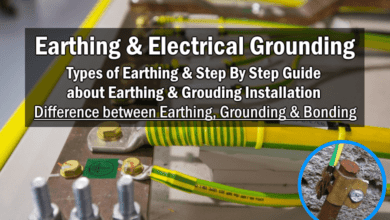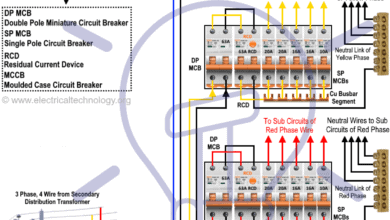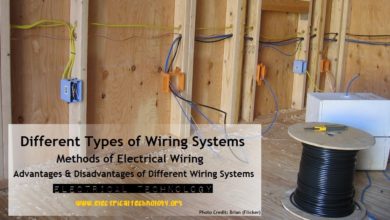3-Point Starter – Circuit and Working of Three-Point Starter
What is Three-Point Starter? Working and Circuit Diagram of 3-Point Starter
What is a Three-Point Starter?
A Three-Point starter consists of a tapped resistor which is sealed in a ventilated box. The main function of the starter is to reduce the flowing current in the armature circuit in the starting period. It is mainly used to control the starting current without speed control of DC motors.
The connection diagram of a Three-Point starter with a DC shunt motor is shown in the figure below.
Construction
A Three-Point starter consists of a starting resistance divided into multiple parts that are connected in series with the shunt field winding. Each part is connected to a brass stud. It also consists of two protective devices; no-volt release and over-load release. This starter has three terminals; L, F, and A. Therefore, this starter is known as a Three-Point starter.
Terminal A is connected to one terminal of armature winding and the last stud (On position) of the starting resistance. Terminal L is connected to the positive supply through the main switch. Hence, it connects the supply to the series resistance via overload release.
One end of the arm has a spiral spring S. The spring is used to hold the arm OFF position during standstill conditions. Also, during the running condition, if the supply is failed, this spring brings the arm to the OFF position due to the spiral torque of the spring. A soft iron keeper is placed at the center of the arm. During the normal running condition, the soft iron keeper is attracted to the no-volt release or holding coil.
The last brass stud is connected to terminal F and when the arm is connected to this point the additional resistance is zero. One terminal of shunt field winding is connected to terminal F. The negative terminal of supply is connected with the remaining terminals of the armature and shunt field winding of the DC shunt motor.
Working
Due to the spiral force of the spring, the starter arm is in the OFF position when the motor is in stand-still condition. The DC supply is given to the motor by closing the main switch. After that, the starter arm is moved to the first stud. In this condition, the entire resistance of starting resistor is connected in series with the armature winding, and the field winding is connected directly with the supply.
Now, the motor starts to run, and the holding coil starts to energize. As the starting arm moves further, the resistance is cut from the circuit. When the arm reaches to ON position, the holding coil energies enough to hold the soft iron keeper. The arm should not be stopped or held for a long time in an intermediate position. Otherwise, the starting resistance may burn out.
What is the Function of No-volt Release?
When the motor reaches the normal speed and the arm is reached the ON position, the entire starting resistance is cut off from the circuit. Now in running condition, if the supply is interrupted or disconnected, the starting arm remains at the ON position. And when the supply is restored, there is no back EMF in the circuit and armature winding is connected directly across the main supply.
Therefore, in this condition, an excessive amount of current starts flowing through the armature winding and it may damage. So, to avoid this situation no-volt release is used in a circuit to pull back the arm to the OFF position.
The no-release coil consists of an electromagnet that is connected in series with the shunt field winding. When the supply is ON, it attracts the soft iron keeper. But if the supply fails or interrupted, the electromagnet is demagnetized and releases a soft iron keeper. Due to the spiral force of the spring, the arm is pulled back to the OFF position and disconnects the main supply.
Also, another function of no-volt release is that it prevents open-circuit in shunt field winding. Because the no-volt release is connected in series with the shunt field winding. If the shunt filed winding is open-circuited, the current flowing through the no-volt release is zero. And it demagnetizes the coil and releases the arm to the OFF position.
What is the Function of Overload Release?
Another protective device overload release is connected in series with the motor to avoid the overload condition. As this device is connected in series with the motor, the current flows through the motor are the same current that flows through the overload release.
The overload release consists of a coil. In normal conditions, the current flows through this coil are not enough for the pull armature in an upward direction. But, in an overload condition, an excess amount of current will flow through the motor and coil of overload release. And this high amount of current is sufficient to pull the armature in an upward direction.
So, as the armature is pulled up, it short-circuited the no-volt release and resulted to demagnetize the no-volt release coil. So, the soft iron keeper detached from the no-volt release, and the arm is pulled back to the OFF position. Hence, in overload conditions, the motor will disconnect from the supply with the help of overload release.
Disadvantage of Three-Point Starter
The speed of the DC motor is controlled by controlling resistance connected in series with field winding. The speed of the motor is inversely proportional to the flux N ∝ 1/ϕ. Hence, the motor speed can be increased by decreasing flux. And the flux can be decreased by decreasing the field current. The field current is controlled by field resistance.
In a Three-Point starter, the field winding is connected in series with the no-volt coil. Therefore, the current that passes through the field winding is the same as the current that passes through the no-volt coil. For speed control purposes, the field current is decreased, and also, the current that passes through the no-volt coil is decreased.
During the normal running condition, the no-volt coil produces electromagnetic pull force to attract the soft-iron keeper against the spring force. But in this condition, the current is reduced and it results in the spring force being higher than the electromagnetic pull. Hence, due to spring tension, the arm is pulled back to the OFF position and the supply is disconnected from the motor. So, a Three-Point starter is not suitable for variable speed control of a DC motor.
The solution to this disadvantage is a Four-point starter.
Related Posts:
- What is Motor Starter? Types of Motor Starters and Motor Starting Methods
- What is a Contactor ? Types, Working and Applications
- What is the Necessity of a Starter in AC and DC Motors?
- Star Delta Starter – (Y-Δ) Starter Power, Control and Wiring Connection
- Direct Online Starter – DOL Starter Wiring Diagram for Motors
- What is Soft Starter? Its Working, Diagram and Applications
- Speed Control of DC Motor – Voltage, Rheostatic & Flux Control Methods
- Main Difference between Contactor and Starter
- Cable Size Calculation for LT and HT Motors
- Starting & Stopping of 3-Phase Motor from more than One Place Power & Control diagrams
- Three Phase Motor Power & Control Wiring Diagrams







